My Postmedia career began September 2013 with a tour of the Edmonton Journal’s downtown office.
Stephanie Coombs, the managing editor of the historic city newspaper, led me through the empty first floor; where the once-mighty department for the classifieds once resided, now occupied by two clerks at a front counter. We wandered through empty halls of forlorn cubicles and desks, past relics of a prosperous past—a glossy magazine, photo studio, employee fitness centre. Past the large, now-shuttered cafeteria. A handful of people were huddled in Finance and HR on the second floor; half of the third-floor advertising department was empty; a few techies were tucked in a fourth-floor corner beside the abandoned library and darkroom. We arrived finally at the fifth floor, at a newsroom built for a robust staff of 200 that now held fewer than seventy journalists. My new team.
I gave a short, flustered speech and was eventually ushered into the eerily quiet former editor-in-chief’s office; gleaming cherry wood desk, slightly worn chair, shadows on the wall where the art once hung. I was alone, seemingly miles from what was left of the newsroom. My computer pinged. It was an email from the building superintendent to all staff: Used office furniture sale this Friday; reasonably priced, everything must go.
I got home late that night, carefully placed a large bottle of gin on the counter and said slowly, with conviction, “It’s going to be great. Honest.”
Founded in 1903, the Edmonton Journal was a jewel in the Southam Newspaper chain that stretched across the country for decades. The Hamilton Spectator, the Ottawa Citizen, Montreal Gazette, Calgary Herald, Winnipeg Tribune, Vancouver Sun, and other Southam papers were the hearts of their communities; their conscience, biggest fans, historians. Powerful and highly profitable businesses, they annoyed politicians and advocated for the underdogs. The publishers and editors wielded tremendous influence, and, by and large, used it wisely.
Like any successful local business, these newspapers played a strong philanthropic role in their communities. The Journal sponsored an annual track and field event for kids for twenty-five years, and each of the city’s high-school theatre troupes. It heavily supported the arts, its name prominently on the city’s downtown concert hall and in banners at every major festival. It sponsored and promoted everything from toy drives to summer camps to women’s shelter fundraisers.
Like any paper, the Journal did lots of toss-away journalism, but lots of great work, too. It succeeded in rolling back a 60 percent wage hike that city council voted for itself in a secret meeting in 1979. It raised serious concerns about the judicial system’s reliance on psychiatric testimony. It won a four-year battle to overturn the province’s draconian ban on information regarding the deaths of children in care. It is the only paper in Canada to have ever won a Pulitzer Prize.
The paper remained such a credible community forum that in 2014, embattled premier Alison Redford chose to announce her resignation in an open letter on the pages of the Journal and our sister paper, the Calgary Herald.

For most of the last century, newspapers were a licence to print money. Sports car-driving sales people boasted of turning down clients because the paper was too full; they couldn’t take another ad. Newspapers were the only game in town and clients came to them. Yearly profit margins of well over 20 percent were common. And the Edmonton Journal was one of the strongest.
Journal management was so supportive and generous to its workers, a union drive in the 1990s was roundly rejected by fully 77 percent of the employees, unheard of at that time.
That decision may have come back to haunt them. On January 19, 2016, twenty-five of us were let go—from rookies to veterans of more than forty years. Starting with me.
Then again, we weren’t working for the Southam family that day.
Southam’s empire was purchased by Conrad Black’s Hollinger Inc. two decades earlier and sold again in 2000 to Izzy Asper’s Canwest Global Communications, with much of the $3.2 billion purchase price using borrowed money. In 2009, six years after Asper’s death, Canwest declared bankruptcy.
Surprisingly, there were several interested buyers. Soon to be Postmedia CEO Paul Godfrey led the winning $1.1-billion bid, largely backed by GoldenTree Asset Management, a New York hedge fund that buys distressed assets and slashes costs to turn businesses around. The other two leading Postmedia investors, Silver Point Capital LP, and FirstMark Capital, are also from the US.
Like Canwest before it, Postmedia is mired in debt. Its most recent (November 30, 2015) quarterly financial report shows that debt at $643 million; it has $19.4 million in operating income and owes $18.7 million in interest payments. With revenues falling by double digits each quarter and a good chunk of that debt in US dollars, these results are more than grim. “What’s really hurtful to us (is the) second-lien notes are all in US funds,” Godfrey told the Canadian Press* in January. “With the Canadian dollar falling the way it’s falling, that’s almost like a noose around your neck.”
The network has sold or is selling every physical asset it owns, from the Calgary Herald building to the Journal and Montreal Gazette printing plants. It is running out of assets and running out of time.
Unless the sickening plunge in revenues somehow stops or its debt is dramatically restructured, bankruptcy seems inevitable. And remarkably, it owns most of this country’s newspapers.
How did we get here, with one company owning 214 of Canada’s newspapers? Very, very quickly. Just last year, in fact. But things started to go south about a decade ago.
You can’t blame Canwest alone for its newspaper woes in 2009. At the heart of the story is industry complacency, an across the board refusal by newspaper owners and leaders to innovate, and a failure to recognize the threat posed by the Internet. It happened first in America. Around 2007, US papers (bloated by good times and struggling with debt) started to fail by the dozens as ad revenues plunged.
I was months from becoming the editor of the Winnipeg Free Press in 2007 when its publisher Andy Ritchie boasted about his “world class classifieds” department, which was still—miraculously and for no reason other than the fact that the Canadian market was behind the curve—bringing in millions of revenue.
One year later, our classified revenues were gutted, too, as the market caught up to our American neighbours, and people fled en masse to cheap online alternatives like Kijiji and e-Bay. And it was too late for the paper to come up with a better digital option.
Canwest entered into its blockbuster deal banking on the fact that “convergence,” the marriage of TV and newspapers, would keep its audience enthralled and advertisers captive. It didn’t play out that way. It also bought into Conrad Black’s ambitious and expensive dream, to build a national voice for the country’s conservative thinkers in the National Post.
Launched in 1998, the Post cost millions to start up, and continued to bleed red ink for a full thirteen years before posting its first (and short lived) profit in 2011. Despite a few high-level pushes to close it down and stop the bleeding, fierce political interests kept the Post going. Even during the Canwest years, the paper’s circulation and distribution declined to the point that the claim it is a national paper is no longer, strictly speaking, accurate.
To the rest of the chain that supported it, the National Post was and still is an unfathomable and unsustainable albatross. And yet, it lives on.
Most employees of the Winnipeg Free Press, where Canwest was headquartered, feared being swept into the struggling behemoth in the late 2000s. One of the few remaining independent papers in Canada (after being purchased from the Thomson chain in 2001), the Free Press looked like an island of stability compared to Canwest.
It seemed to us that Canwest’s senior executives shared a strategic and corporate vision that was sucking all the initiative, not to mention life and personality, out of their big-city news teams.
In 2002, the Ottawa Citizen’s publisher was fired over a series of editorials Izzy Asper just didn’t like, and many strong regional leaders like Journal publisher and CEO Linda Hughes quit as downsizing became the order of the day.
Around 2006, Gerry Nott, editor and publisher of the Ottawa Citizen (now the senior vice president of content for Postmedia), was given the big job of creating Canwest’s own national wire service in Ottawa; a central story-sharing network to which all of its newspapers contributed. It was designed to save the metros money by cutting their ties to Canadian Press, the nation’s news co-operative. By 2013, the internal service had failed; attentive readers will notice CP photos and stories today in their Postmedia papers.
But it had also been superseded by a new Postmedia project—a central desk in Toronto, set up to assign, select, and edit each one of its newspapers’ non-local news stories, from sports to arts to national and world.
Another significant cost-cutter was a single copy-desk operation, set up in a Hamilton strip mall. One team to proofread stories and design pages for all of the papers—an opportunity to let go hundreds of their people across the country.
“Canwest Editorial Services [now redubbed PES, or Postmedia Editorial Services] provides complete newspaper production outsourcing solutions . . . ” states its out-of-date website. “Publishers today at all levels are recognizing that technology has enabled innovation and bottomline savings. We are here to help you follow through on this realization . . . . Call us or come for a site visit to Hamilton, Ontario, a central location with 120 million North Americans within a 500-mile radius. See for yourself why our model of client-dedicated production teams has delivered savings to our customers.”
I toured the place in 2007, getting the pitch from Nott on the drive down from Toronto. Basically it was “Why have your own staff doing the work these people can do for you, for so much less? ” A potent argument, mostly because the readers wouldn’t notice.
Coordinating, sharing, and outsourcing production, proofing and other unglamorous editorial tasks saves newsroom budgets for “content producers” like reporters and photographers, otherwise known as the stuff readers do notice.
Then the tour began, a distinctly depressing stroll past Regina Leader-Post sports pages, Arts fronts for the Montreal Gazette, editorial pages for the Vancouver Sun. The art director told me he was only allowed to use certain templates for section fronts—careful, pretty and bland, the opposite of what I was used to from the Free Press’s brilliant art director.
I leaned over one twentysomething’s** shoulder and asked how he was able to edit an op-ed about Granville Street. “Have you ever seen Vancouver?” I asked.
“I’ve never been outside of Hamilton,” he said. “But I’d like to.”
Free Press publisher Bob Cox ultimately declined the service, deciding to keep his local expertise. But for Canwest’s publishers and editors, there was no such choice. Their local copy editors and layout people, designers, graphic artists, national and world news editors were all let go. All of that work was outsourced to Ontario.
What the newspapers lost in independence, they gained in being able to hang on to as many local writers and photographers as possible, but it created a peculiarly passive dynamic in the halved metro newsrooms. Where they once had the autonomy to make certain decisions, editors were increasingly told it was not their business.
The cost-cutting synergies continued: Why have local political reporters in Ottawa when the chain can cover it for all? How many folks do you need at a legislature when papers can share one story? Section editors were told if it was not a local page, they had little-to-no input, demoralizing when readers called to complain to the name on the masthead.
Many old and once solid community institutions—most recently the Guelph Mercury and the Nanaimo Daily News—have died. And the once-mighty Southam newsrooms are all now breathing on the same respirator.
People may not notice. How do you measure the slow gutting of a metro newspaper, the largest newsroom in town?
Court and crime and car crashes stay in the headlines because they are cheap and easy to cover. What disappears is the substantive stories that contribute to a community’s sense of self and worth; programs that require a spotlight, business and arts trends, political coverage and context.
Good journalism is more than a mirror; it also tells communities what they can and should be.
So as Canada’s metro newsrooms die (or are, as the Huffington Post so cheekily proclaimed in January, “being murdered”), most journalists look to new business models to fund the kind of work these giants once delivered.
Because that’s what matters. Not the dead-tree platform of Ben Franklin’s day.
By the time I arrived at the Journal, the drive to centralize power at Postmedia was snowballing.
Why employ local publishers if their loyalties were to their community and their staff, rather than dedicated to the health of the overall company? Most were let go in the spring of 2013, replaced by “regional” leaders.
The instatement of corporate executives in lieu of local publishers may have rid Postmedia of irritating pushback from metro papers, but it also effectively cut ties to the communities these papers had worked to build over the years.
When a local paper doesn’t seem local anymore—when it loses its ability to be a community partner—it loses credibility with the business community, which further impacts sales.
Postmedia executives came up with an audacious plan in 2012. Each local newsroom would produce specific content across four platforms: mobile, web, tablet, and print. Advertisers would embrace the new tablet edition, envisioned as a curated evening news magazine, interactive and awesome, like a newspaper on steroids. The company would also redesign and realign all of its print brands, committing to a remarkable $25-million investment in newspapers despite Postmedia’s escalating debts.
Of course, there were savings in this plan as well, as every major daily dropped its individual masthead and print design to become a more efficient, cookie-cutter template. The drive was for more common pages and section fronts across the chain, to simplify the jobs of the Hamilton page designers and copy editors.
Your readers won’t notice, I was told. They don’t read the other newspapers. The four-platform strategy launched at the Ottawa Citizen in the spring of 2014. The tablet sucked up huge resources, but it brought out the best in the newsroom’s photographers and writers.
Unfortunately, as launch time approached, tablet sales started to decline and the mobile phone audience started to balloon. Advertisers didn’t flock to the tablet, not enough people read it, and Postmedia’s debt continued to rise.
Though we had our own tablet team in place, we were put on hold two weeks before the Journal’s scheduled relaunch in February 2015. Something much bigger was preoccupying our executive team.
Three months prior, Godfrey had announced a bid to buy another Canadian news network, Quebecor’s Sun Media chain, which included 175 titles, including the Toronto, Calgary, Edmonton, and Ottawa Suns, small dailies like the London Free Press, and Fort McMurray Today, and a host of weeklies.
The deal, some might argue in hindsight, seemed preposterous. How could Canada let one media organization buy up virtually all of its newsrooms? As recently as ten years ago, a newspaper merger of this scale would have provoked public outcry and calls for a royal commission, Godfrey told the Financial Post. But this time, there wasn’t a peep.
Godfrey argued eloquently that the purchase was only “buying a longer runway” for two threatened franchises. Before the deal could be sealed, it had to pass through the Competition Bureau, and Godfrey personally took it upon himself to convince leaders in three two-paper markets in particular (Ottawa, Edmonton, and Calgary) that the Postmedia buy was good for competition, and good for Canada.
I attended two of his private dinners in fine Alberta restaurants where he vowed to keep the newsrooms separate. We might even have to reinvest in the Sun newsrooms, he mused aloud in Calgary, so challenged after years with the spendthrift Quebecor chain. The thirty-year rival papers would operate just as the two Postmedia-owned papers in Vancouver, the Sun and the Province, have operated for decades. They’d be competitive, distinct, and entirely independent, he said.
What we really want out of this, Godfrey told everyone, is the digital portal—combining Canoe.com and all the newspapers’ digital portals vaulted Postmedia to among the biggest in Canada and made the company much more appealing to digital advertisers.
Postmedia managed to borrow another $316 million for the purchase to make the deal. Godfrey received a total salary of $1.76 million in 2015, including a $400,000 bonus for the Sun Media acquisition. The deal passed through the Competition Bureau in March 2015 without a murmur.
And Postmedia, Godfrey told the Financial Post, became the “strongest newspaper chain in Canada.”
We never got to launch a tablet edition in Edmonton. The great experiment was quietly killed off in the spring of 2015, and our tablet team was laid off or reassigned. We launched a three-platform version in September 2015, instead, which included a surprise for print readers.
Edmonton was the first Postmedia paper to feature a special section compiled and produced by the National Post. Inspired by a highly successful experiment by the Gannett newspaper chain with USA Today, it would result in significant savings as it rolled out across Canada—just one daily national/world news section for all the Postmedia papers.
But Postmedia cared about the deal for another reason. USA Today’s circulation was sagging when Gannett started inserting a condensed version of it into its regional newspapers. Today, it is back on top as the largest-circulating newspaper in America. It is able to claim each one of those metro papers’ subscribers.
Postmedia is banking that the Post will get a similar circulation boost as it rolls out across the chain, coming soon to Vancouver and Ottawa.
Do the readers notice? Some. “I’ve said no to that right-wing paper for fifteen years,” one subscriber said as he cancelled. “If I wanted to buy it, I would have.”
But most appear to like it, or not dislike it enough to abandon the Journal. Newspaper readers are a tremendously loyal, albeit dwindling, demographic.
On my last day with Postmedia, a 7 a.m. email from Nott arrived, asking to meet him in an hour at a downtown hotel. By 8 a.m., I was out the door. I got a call from a deeply distressed Coombs. “I’m gone, too,” she said.
Nott announced our dismissals to staff at 11 a.m., and then he and former Journal editor Lucinda Chodan, who had flown in from Montreal for the week, called them down one by one to be let go, or invited to stay on as one of the team.
That team was a new bold initiative to save costs at Postmedia. Why duplicate services in two separate newsrooms? Combine the two-paper towns into one newsroom each, serving both platforms. Cut local “content producers” by half. Editors choose and tailor content for both papers. Columnists keep their jobs because they represent each paper’s brand and personality.
Hopefully, the readers don’t notice.
The 133-year-old Calgary Herald also lost almost 40 percent of its staff, and merged with a shadow of the Calgary Sun newsroom to put out two papers. The 171-year-old Ottawa Citizen merged newsrooms with the Ottawa Sun; the Vancouver Sun and Province to follow. A national desk was set up to run sports for each paper, allowing Postmedia to cut local sports desks as well.
“This was absolutely not the plan from the start. It was a plan formed on the basis of the realities we face every day,” Nott later told the Financial Post, adding that it was a sad day for everybody.
Those realities Postmedia faces are fierce and bleak. At this rate of decline, most of the country’s newspapers could be gone by 2017. No one in Canada, apparently, is noticing.
As the news started to leak out on social media, Coombs and I returned downtown. We set up shop at the dark little Hat bar on Jasper Avenue, a block from the Journal/Sun building and greeted shell-shocked staffers as they straggled in. Some were staying; some were going. All knew it was the end of an era. I told them what I had been telling them for two-and-a-half years.
They were the nicest newsroom I had ever worked at—close, collaborative, and creative. Years of steady and traumatic decline had left behind a core of wholly dedicated people. Years of buyouts had peeled off the bitter and the angry. There were no toxic attitudes left in that newsroom; they looked after each other, they took pride in the team, and they worked hard. When it came to the Journal, they gave their all.
Between 2013 and 2015 the Edmonton Journal won a Michener citation, three National Newspaper Awards, the Hillman Prize and more than a dozen other honours. They were amazing.
It was too soon. But I wanted to tell them.
It was great. Honest.
* An earlier version of this article incorrectly attributed this quote to the Financial Post.
** An earlier version of this article misstated the copy editor’s age.





